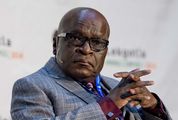WITH a new global economic slowdown under way, SA’s youth not in employment, education or training — the NEETs — are becoming increasingly and dangerously unemployable.
SA’s most troubling statistic is its numbers of economically disenfranchised youth aged 15 to 24, with the NEET rate climbing above 50% after the age of 22.
Statistics SA (Stats SA) currently pegs the total NEET rate at 39.4% of youth — or 3.4-million people — though this has declined from 42% in 2009.
Despite political battles over the interpretation of the Stats SA numbers, there is broad agreement among government and civil society organisations that youth unemployment is a huge problem and needs to be tackled urgently.
Under a rather elastic definition, youth unemployment can only be expected to increase as economic growth tails off as expected in the coming years.
SA’s youth unemployment has consistently worsened since the last major global economic slowdown in 2008, even for those who obtain their matric and complete their tertiary education.
According to Stats SA, long-term unemployment among the youth is pegged at 61.9% this year, up from 54.9% in 2008.
Unemployment rates among the youth — statistically and in legal terms in SA defined as people up to age 35 — are consistently double the unemployment rates for adults.
Youth and women are disproportionately affected by structural problems in the economy in which growth rates are not matched by labour absorption rates.
Speaking at a recent incubation forum, Deputy Finance Minister Mcebisi Jonas acknowledged that youth and women struggle to find sustained employment.
Sustained growth rates of up to 5% were required to tackle an unemployment rate that had hovered around the 25% mark since 1994, said Jonas.
Department of Basic Education spokesman Elijah Mhlanga said that despite recent improvements, "there are too many youths who do not reach matric and consequently lack any qualification that is well recognised in the labour market".
The ratio of matric passes in 2013 to Grade 2 enrolments in 2003 is 40.4%. Mhlanga said this was probably an underestimate by about 3 percentage points due to grade repetition, mortality and the fact that supplementary National Senior Certificate candidates were not yet included.
"Importantly, this Grade 2-to-matric throughput rate has increased steadily in the past few years, from 28.0% in 2009 to 34.2% in 2010, 37.7% in 2011, 38.2% in 2012 and 40.4% in 2013," he said.
...
CALCULATIONS using Stats SA household survey data also show that slightly more than 40% of SA’s youth end up passing matric. This secondary school completion rate is still low relative to comparable developing countries, such as Turkey (53%) and Brazil (67%).
"But, encouragingly, these household surveys indicate a moderately positive trend in the attainment of matric since 2002, in particular amongst females," Mhlanga said.
"With a clear relationship between highest education attainment and employability, a further dismal statistic is that around half of pupils who progress to university can be expected to drop out in their first year."
He said this problem could be solved by steadily increasing the proportion of youth who attain matric, "but crucially, this must be achieved through improving the quality of learning in earlier grades".
"The high rates of dropout in Grades 10 and 11 are symptomatic of the learning deficits that children accumulate in earlier grades. Although factors such as financial constraints, gang involvement and family commitments play a role in children dropping out, the major cause of is weak learning foundations.
"For this reason, our interventions to improve the acquisition of foundational numeracy and literacy, especially reading acquisition, will be crucial."
Mhlanga said a second part of the solution was to develop meaningful educational alternatives for those pupils who did not manage to achieve matric.
The increasing policy focus on Further Education and Training colleges, learnerships and apprenticeships was welcomed by the Department of Basic Education.
...
ACCORDING to Stats SA’s second-quarter labour survey, the unemployment rate decreased 1.4% to 25% between the first and second quarters of 2015, although the number of discouraged work seekers climbed. The absorption rate increased 43.2% between the first and second quarters of the year‚ while the labour force participation rate declined to 58.1% from 58.6% over the same period.
The Stats SA report notes that in the second quarter, labour market participation rates deteriorated by a larger margin among the youth compared with adults, despite an improvement in profiles of education over the period.
For the youth, unemployment rates for those with less than a secondary education increased from 37.7% in 2008 to 41.9% in the first quarter of 2015. For those with matric, unemployment rates increased from 32.5% to 36.6%, while for those with tertiary education, unemployment increased from 15.5% to 21.2%.
These increases are, however, similar for adults, with the unemployment rate among those with tertiary education more than doubling from 3.5% in 2008 to 7.2% 2015, the Stats SA report reads.
The statistics are only mildly affected by Stats SA changes to its master sample, now based on 2011 census data rather than 2007 data.
Stats SA executive manager of labour statistics Desiree Manamela says the emphasis is on annual and not quarterly trends, with the organisation, for example, having over many years observed changes from the first quarter to the fourth.
Stats SA would monitor all four quarters of 2015 to gauge whether the statistics had stabilised with the use of the new master sample, Manamela said.
The Department of Higher Education and Training is seeking to capacitate the Technical Vocational Education and Training sector and has a number of programmes aimed at ensuring students gain access to work experience.
Amid broader efforts to figure out the gap between schooling, tertiary education and the workplace, the department seeks to develop meaningful alternatives for those who will not achieve matric, as well as "institutions of first choice" for those seeking more technical vocations.
Homecoming Revolution CEO Angel Jones says there are 800,000 scarce skills vacancies in SA.
The group estimates that filling one such vacancy directly or indirectly translates into the creation of one more job.
The University of Johannesburg has a programme to ensure that its graduates in the IT and engineering fields receive on-the-job training before heading into the workplace.
A R400m joint Nationals Skills Fund and university initiative, the Resolution Circle initiative launched in 2011, provides workplace training, largely for students studying towards diplomas. CEO Prof Willem Clarke says while the initiative often gives the students access to higher levels of technology than in the workplace, its existence is a reflection of the lack of availability for practical training in the private sector.
"With the economic crisis, as well as the competitive environment, a lot of these training workshops (in the private sector) have been closed. It is an expense and it is usually not core to the businesses," he said.
A Youth Employment Accord signed in 2013 by the government and its social partner has a range of measures aimed at promoting youth employment, among them "set-asides" for youth in specific industries, a large increase in internships in the government and the creation of youth brigades.
National Youth Development Agency executive chairman Yershen Pillay says much of the agency’s focus over the next three to five years will be to give expression to the accord through the establishment of a "mass-based national youth service programme".
...
THE focus of the agency — which was established in 2008 to tackle youth development issues — would continue and its priority was skills and education development in line with the government’s focus, he said. "Half of our efforts will remain on education and skills development, and the other half will be split between career guidance activities, youth service and entrepreneurship."

Statistics SA says that 39.4% of youth — or 3.4-million people — are not in employment, education or training. With the country’s economic outlook bleak over the next few years, this rate is expected to grow. Picture: REUTERS/SIPHIWE SIBEKO
WITH a new global economic slowdown under way, SA’s youth not in employment, education or training — the NEETs — are becoming increasingly and dangerously unemployable.
SA’s most troubling statistic is its numbers of economically disenfranchised youth aged 15 to 24, with the NEET rate climbing above 50% after the age of 22.
Statistics SA (Stats SA) currently pegs the total NEET rate at 39.4% of youth — or 3.4-million people — though this has declined from 42% in 2009.
Despite political battles over the interpretation of the Stats SA numbers, there is broad agreement among government and civil society organisations that youth unemployment is a huge problem and needs to be tackled urgently.
Under a rather elastic definition, youth unemployment can only be expected to increase as economic growth tails off as expected in the coming years.
SA’s youth unemployment has consistently worsened since the last major global economic slowdown in 2008, even for those who obtain their matric and complete their tertiary education.
According to Stats SA, long-term unemployment among the youth is pegged at 61.9% this year, up from 54.9% in 2008.
Unemployment rates among the youth — statistically and in legal terms in SA defined as people up to age 35 — are consistently double the unemployment rates for adults.
Youth and women are disproportionately affected by structural problems in the economy in which growth rates are not matched by labour absorption rates.
Speaking at a recent incubation forum, Deputy Finance Minister Mcebisi Jonas acknowledged that youth and women struggle to find sustained employment.
Sustained growth rates of up to 5% were required to tackle an unemployment rate that had hovered around the 25% mark since 1994, said Jonas.
Department of Basic Education spokesman Elijah Mhlanga said that despite recent improvements, "there are too many youths who do not reach matric and consequently lack any qualification that is well recognised in the labour market".
The ratio of matric passes in 2013 to Grade 2 enrolments in 2003 is 40.4%. Mhlanga said this was probably an underestimate by about 3 percentage points due to grade repetition, mortality and the fact that supplementary National Senior Certificate candidates were not yet included.
"Importantly, this Grade 2-to-matric throughput rate has increased steadily in the past few years, from 28.0% in 2009 to 34.2% in 2010, 37.7% in 2011, 38.2% in 2012 and 40.4% in 2013," he said.
...
CALCULATIONS using Stats SA household survey data also show that slightly more than 40% of SA’s youth end up passing matric. This secondary school completion rate is still low relative to comparable developing countries, such as Turkey (53%) and Brazil (67%).
"But, encouragingly, these household surveys indicate a moderately positive trend in the attainment of matric since 2002, in particular amongst females," Mhlanga said.
"With a clear relationship between highest education attainment and employability, a further dismal statistic is that around half of pupils who progress to university can be expected to drop out in their first year."
He said this problem could be solved by steadily increasing the proportion of youth who attain matric, "but crucially, this must be achieved through improving the quality of learning in earlier grades".
"The high rates of dropout in Grades 10 and 11 are symptomatic of the learning deficits that children accumulate in earlier grades. Although factors such as financial constraints, gang involvement and family commitments play a role in children dropping out, the major cause of is weak learning foundations.
"For this reason, our interventions to improve the acquisition of foundational numeracy and literacy, especially reading acquisition, will be crucial."
Mhlanga said a second part of the solution was to develop meaningful educational alternatives for those pupils who did not manage to achieve matric.
The increasing policy focus on Further Education and Training colleges, learnerships and apprenticeships was welcomed by the Department of Basic Education.
...
ACCORDING to Stats SA’s second-quarter labour survey, the unemployment rate decreased 1.4% to 25% between the first and second quarters of 2015, although the number of discouraged work seekers climbed. The absorption rate increased 43.2% between the first and second quarters of the year‚ while the labour force participation rate declined to 58.1% from 58.6% over the same period.
The Stats SA report notes that in the second quarter, labour market participation rates deteriorated by a larger margin among the youth compared with adults, despite an improvement in profiles of education over the period.
For the youth, unemployment rates for those with less than a secondary education increased from 37.7% in 2008 to 41.9% in the first quarter of 2015. For those with matric, unemployment rates increased from 32.5% to 36.6%, while for those with tertiary education, unemployment increased from 15.5% to 21.2%.
These increases are, however, similar for adults, with the unemployment rate among those with tertiary education more than doubling from 3.5% in 2008 to 7.2% 2015, the Stats SA report reads.
The statistics are only mildly affected by Stats SA changes to its master sample, now based on 2011 census data rather than 2007 data.
Stats SA executive manager of labour statistics Desiree Manamela says the emphasis is on annual and not quarterly trends, with the organisation, for example, having over many years observed changes from the first quarter to the fourth.
Stats SA would monitor all four quarters of 2015 to gauge whether the statistics had stabilised with the use of the new master sample, Manamela said.
The Department of Higher Education and Training is seeking to capacitate the Technical Vocational Education and Training sector and has a number of programmes aimed at ensuring students gain access to work experience.
Amid broader efforts to figure out the gap between schooling, tertiary education and the workplace, the department seeks to develop meaningful alternatives for those who will not achieve matric, as well as "institutions of first choice" for those seeking more technical vocations.
Homecoming Revolution CEO Angel Jones says there are 800,000 scarce skills vacancies in SA.
The group estimates that filling one such vacancy directly or indirectly translates into the creation of one more job.
The University of Johannesburg has a programme to ensure that its graduates in the IT and engineering fields receive on-the-job training before heading into the workplace.
A R400m joint Nationals Skills Fund and university initiative, the Resolution Circle initiative launched in 2011, provides workplace training, largely for students studying towards diplomas. CEO Prof Willem Clarke says while the initiative often gives the students access to higher levels of technology than in the workplace, its existence is a reflection of the lack of availability for practical training in the private sector.
"With the economic crisis, as well as the competitive environment, a lot of these training workshops (in the private sector) have been closed. It is an expense and it is usually not core to the businesses," he said.
A Youth Employment Accord signed in 2013 by the government and its social partner has a range of measures aimed at promoting youth employment, among them "set-asides" for youth in specific industries, a large increase in internships in the government and the creation of youth brigades.
National Youth Development Agency executive chairman Yershen Pillay says much of the agency’s focus over the next three to five years will be to give expression to the accord through the establishment of a "mass-based national youth service programme".
...
THE focus of the agency — which was established in 2008 to tackle youth development issues — would continue and its priority was skills and education development in line with the government’s focus, he said. "Half of our efforts will remain on education and skills development, and the other half will be split between career guidance activities, youth service and entrepreneurship."






















